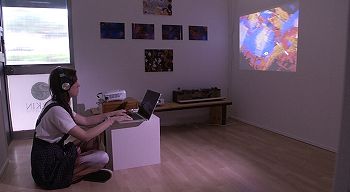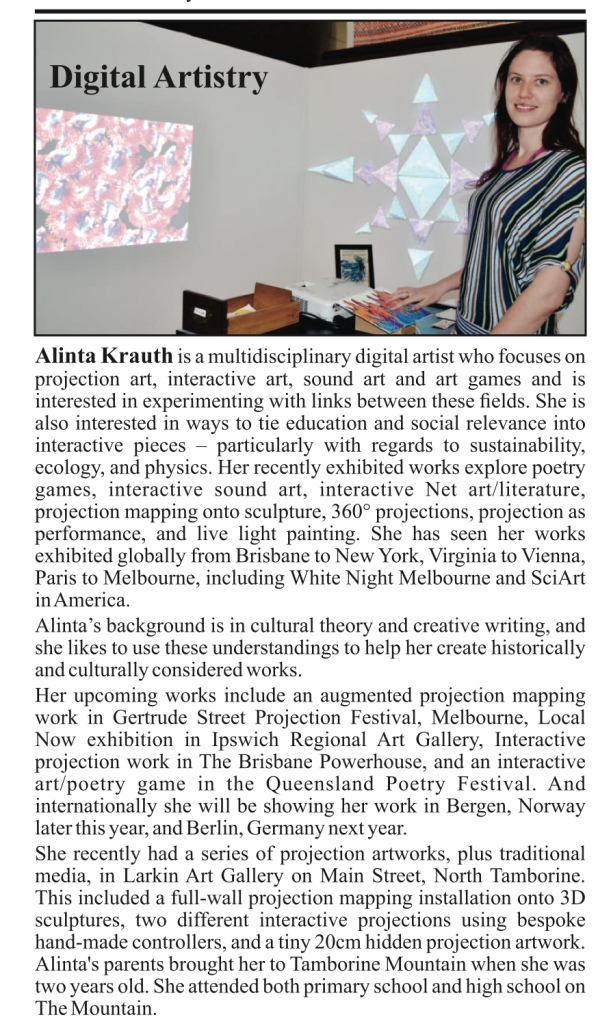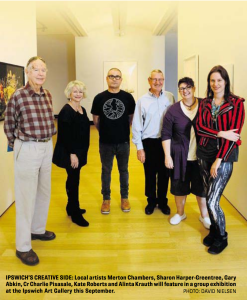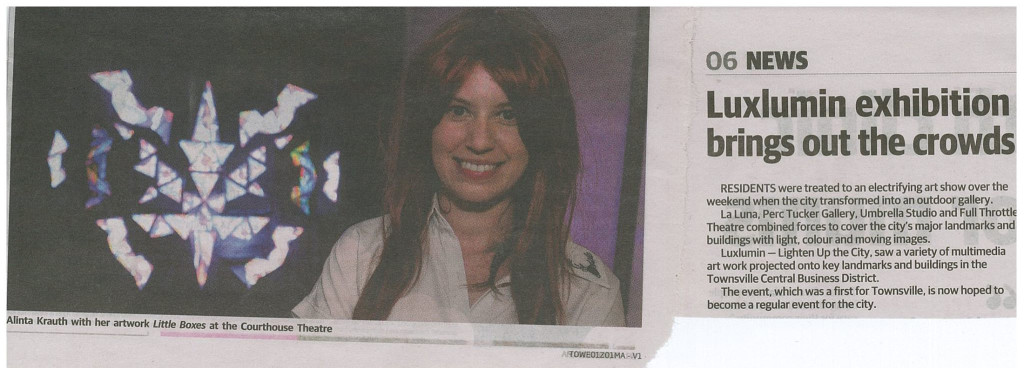- 2018, “Art, Science, and the Environment: How do they overlap?” medium.com featuring interview segments.
- 2018, “The River Enfolds” shown in “Screening Artists”. Adelaide Festival Centre – exhibitions.
- 2018, “Leading Irish and International Writers for 33rd Cuirt Festival”. This Is Galway magazine.
- 2018, “Visiting Fellows arrived today – Alinta Krauth and Jason Nelson”. Moore Institute website and newsletter.
- 2018, “Embodied Encounters: Digital Cartographies”. Cuirt International Festival of Literature. Curated by Anne Karhio. Picture also my work.
- 2018, Alinta Krauth in “Visiting Fellows Scheme” (navigate to 2017/2018).
- 2018, Emer Handly, “NUI Galway to host second International Digital Cultures Conference” Irish Tech News magazine. Picture also my work.
- 2018, Charlie McBride, ‘‘Salty’ and ‘Sustaining’ Cuirt programme unveiled at House Hotel‘. Galway Advertiser. Featured artist/writer for Cuirt International Festival of Literature, Ireland.
- 2018, ‘Meet our Remarkable Alumni‘ Featured as Griffith University Alumni.
- 2018, ‘Alinta Krauth’ Feature for Ian Potter Cultural Trust blog.
- 2018, ‘Art meets science in exploration of environmental research’, Brisbane Times and Sydney Morning Herald.
- 2018 ‘Queensland artists to be parachuted into environmental science labs‘ QLD Government website.
- 2017, Delutz & Rapp, ‘Reflecting Nonhuman Subjectivities’, Interalia Magazine.
- 2017, ‘Machinemenomenology (no. 1)’ for Bergen Utstillingsguide (exhibitions guide).
- 2017, Visual Artists and Festival Design team for BIGSOUND Festival.
- 2017, ‘Holo-Poetry’ premieres at Queensland Poetry Festival and Flying Arts exhibition. On display at Judith Wright Centre of Contemporary Art (Institute of Modern Art).
- 2017, ‘Machinemenomenology (no. 1)’. Current exhibitions at Kunsthall 3.14, Bergen, Norway.
- 2017, ‘Feature Interview – Alinta Krauth’ The Honest Ulsterman, interviewed by Galway Art Centre’s Maeve Mulrennan about digital literature and installation methods. Ireland.
- 2017, Feature artist – Centre for Projection Art, Melbourne, Australia.
- 2017, Tree:Mails is exhibited in ‘Caring for Country’ exhibition, Beaudesert Public Art Gallery, curated by Irene Girsh-Danby.
- 2017, ‘Where are they now? Award Alumni: Alinta Krauth’. Interview with Flying Arts, Australian art alliance.
- 2017, ‘Other Codes: Exhibited Works’ images of ‘Machinimenomenology (no. 1)’ on the big screen, and others who were exhibited in the Other Codes: Digital Literatures in Context exhibition at National University of Ireland.
- 2017, ‘Machinimenomenology (no. 1)’ shows at Other Codes: Digital Literatures in Context conference exhibition at National University of Ireland, after premiering at Galway Arts Centre, Ireland, and Cuirt International Festival of Literature, Ireland.
- 2017, ‘Digital Writing and Poetry’, Cuirt International Festival of Literature write up and event page. Also featured on Mez Breeze Design blog and others.
- 2017, ‘Digital Poet and Fulbright Scholar Jason Nelson and Digital Artist Alinta Krauth’, Moore Research Institute events and news webpage, University of Ireland.
- 2017, Under-Mine features on Kolonie Wedding (arts events for Wedding – suburb of Berlin, Germany) fliers and website homepage.
- 2017, Opening of Under-Mine images, and artist talk images, on Art Laboratory Berlin website.
- 2017, Under-Mine on Transmediale Vorspiel events.
- 2017, ‘Going wrong, turning back, inflexible – Kommunikation mit der nichtmenschlichen Kreatur’ (communicating with the nonhuman creature). Review by Art in Berlin of Nonhuman Subjectivities: Under-Mine solo show at Art Laboratory Berlin.
- 2017, ‘Vernissage: Nonhuman Subjectivities: Under-Mine. Alinta Krauth’. Projektraume Berlin Event page.
- 2017, ‘Artist’s Talk with Alinta Krauth’ Experimental Berlin. (Artist’s talk and guided tour of exhibition)
- 2017, ‘Non-human Subjectivities: Under-Mine’ solo exhibition at Art Laboratory Berlin, Alex Daniel Reinhart’s Art News in Berlin (blog).
- 2017, Alinta Krauth to speak and give workshop on effective public exhibition spaces at ‘Turn on Literature’
- 2017, ‘Portals’ public projection takeover of Bergen Public Library by Alinta Krauth and Jason Nelson.
- 2017, ‘Under-Mine’ solo exhibition for Nonhuman Narratives series at Art Laboratory Berlin premieres. Running from 25th February to 2nd April 2017.
- 2017, some of Alinta Krauth’s experimental sound art on the Witch House album by Das Kabinett.
- 2017, Alinta Krauth guest lectures and gives three day workshop at NTNU (Norwegian University of Science and Technology, Trondheim Academy of Fine Art).
- 2016, ‘Walking Unexpectedly’, published in Unlikely Journal for Creative Arts. Blind peer-reviewed hybrid academic article/interactive net artwork/sound artwork.
- 2016, ‘Entropic Texts’ co-authored with Jason Nelson, premiered at ISEA2015, shows in ‘Shapeshifting Texts’ exhibition, Bremen, Germany.
- 2016, ‘Digital Art and Literature at the University Library Cafe’, editorial by Jill Walker-Rettberg.
- 2016, ‘Utstilling på Bibliotek for humanoria’ (‘Exhibition Library of Humanities’), Bergen University Library write up.
- 2016, ‘A Virtual Bathymetric’ premieres at Piksel Festival 2016. (web catalogue)
- 2016, Bioluminous Walking documentation video shown at Electrofringe festival, Sydney, Australia, 22nd October. See here for program.
- 2016, ‘Artist Talk: Alinta Krauth: Light, Environments and Ecologies for Digital Art‘. University of Bergen Digital Culture. Bergen, Norway.
- 2016, ‘In Space and in Time at ‘The Churchie’ Engage Arts review.
- 2016, ‘Program Host 2016 Bergen Library’ (catalogue of public lectures). p. 23.
- 2016, ‘Fall 2016 Public Library Events’, University of Bergen International Student Blog. Bergen Public Library, Norway, digital artist talk series.
- 2016, ‘Art, Science, and the Environment: How to they Overlap?’ Fringe: Art Culture. Excerpt:
“Krauth’s works explore the interweaving narratives of scientific data… [she] is an expert at using technology to engage the community.”
- 2016, ‘Art Meets Science’ Engage Arts. Review of EcoSciences Precinct exhibition. Excerpt:
“These intriguing holographic vessels… [conjure] up an imagined ‘weather lab’, where different types of weather can be grown. Her interest in this area springing from the vital role that the climate plays in our lives and the unease around the science of weather modification such as cloud seeding”
- 2016, ‘Innovative and Interactive exhibition opens at gallery’, Sunshine Coast Council.
- 2016, ‘Tree:mails: Scenic Rim by Alinta Krauth’ Fringe: Art Culture.
- 2016, ‘Art meets Science Exhibition’, National Science Week.
- 2016, ‘Interview: SciArt Centre’s Alinta Krauth’, SciArt Magazine online. Excerpt:
“Both artists and scientists need to have strong imaginations in order to be great in their field… Every artist needs to be a little bit of a scientist in order to spur their curiosity for the world, and every scientist needs to be a little bit of an artist in order to be innovative. Creativity is what makes innovation, and thus creativity directly influences technology – both in its creation and in its use.”
- 2016, ’23 finalists and judge announced’ The Churchie National Emerging Art Prize.
- 2016, ‘Creators – Alinta Krauth’, Art the Science feature interview.
- 2016, ‘Eclectic Online show Demystifies High Science with Playful Art’ The Creators Project, Andrew Nunes, 23rd July. My work pictured.
- 2016, ‘Art, Science and Technology’ Neo2 Magazine. Uses images of my work ‘Shadows blister those who try to touch’.
- 2016, ‘Inventories’ Frostbitton Design. Small review of my co-authored work with ISEA2015 ‘Entropic Texts’.
- 2016, ‘Artist in Residence Science residency’ info on successful applicants.
- 2016, Panelist. ‘The Burning Glass 2016’. Speaking about the Treemails project and its connections to the work of Judith Wright.
- 2016, Review of Bioluminous Walking. ‘Fluorescent Creatures in the Forest’ Tamborine Times. Page 3.
- 2016, Feature article for my work at GLOW Festival. ‘All Aglow as Art gets Light Touch’ Gold Coast Bulletin. Page 10.
- 2016, Feature article for Bioluminous Walking. ‘Fireflies and More in Environmental Park’ Tamborine News. Page 12.
- 2016, Feature article for Bioluminous Walking. ‘The Five Senses Festival: Fireflies, and More, in the Forest’ Tamborine Times. Page 11.
- 2016, Bioluminous Walking for the 5 Senses Festival.
- 2016, ‘Your guide to GLOW’, Arts and Culture, More Gold Coast.
- 2016, the official council produced documentation of Organic Data featuring ‘If the forest wanders’. There is also a version specifically for my work seen on social media sites.
- 2016, ABC radio interview about Tree:mails: Scenic Rim art project. And full episode: Here (does expire after a period of time).
- 2016, ‘Wrap-Up | Friday Night Laneways Organic Data’. By Engage Arts. Excerpt:
“The audience’s response to this work was overwhelming; people stopped, sat, and even lay down to experience the sense of wonder created by the animation. With the complexity both of this works technical execution and the environmental message obscured, Krauth explored the use of projection, interaction and animation to physically connect the audience to the works elements. Krauth’s art practice continues to provide a subtle but significant reminder of the importance of science and technology and the key role it has to play in conservation.”
- 2016,’Alinta Krauth, If the forest wanders’ feature editorial by Engage Arts. Excerpt:
“If the forest wanders, 2016 offers a moment of digital connection, reminding us of the fragility and beauty of the natural world and the encroachment of urbanization into numerous habitats.”
- 2016, ‘Alinta Krauth: interactive art meets science in Brisbane‘ feature editorial by Fringe:ArtCulture. Excerpt:
“Alinta Krauth is perhaps one of the most important women to come out of Art and Queensland at the moment, because of the way her art explores and conveys scientific data through digital installations, prose, sounds and music, but also because of this, her role as a woman in the ‘tech’ industry.
Her complex digital installations feature interactive sculptures, often combining visual and aural effects with digital poetry in public spaces. She is an expert at creating an environment that engages the senses to trigger physiological responses from viewers, sometimes inviting them to interact with a control box she has created herself. Her work transverses digital fields on and offline, whether it is by using code to create interactive maps of real geographical areas, encouraging people to explore their environment by sending messages to neighbourhood trees, or by taking real data, animating it and overlaying audio to provoke thought and discussion.
Her combination of art and technology is by definition pioneering as each work needs to be site-specific. She has grown accustomed to the challenges and restrictions that come with installations in an array of venues using her talents to prove time and time again, that being a woman does not impede her ability to create art within a technical industry…”
- 2016, ‘Alinta Krauth, Jason Nelson and DJ Craig Parry ‘Organic Data’, Griffith Centre for Creative Arts Research, news page.
- 2016, ‘QPF 2015: Language is a Virus’ documentation film by Gawky Media released. See me talk about my work ‘An Argument in Parallel Completeness’ at 3:54.
- 2016, ‘Organic Data in Fish Lane’ for World Science Festival.
- 2016, ‘Fourth White Night a bit of a light night even with record crowds’. Sydney Morning Herald and The Age. Despite giving some bad reviews of some artworks, they mentioned my work as one of the special surprises. Excerpt:
“You had to dig a bit deeper to find hidden gems such as… Cartology Apology at the Scots’ Church – a trippy, layered piece of animation constructed from topographical maps of Melbourne and surrounds.”
- 2016, ‘White Night Melbourne 2016‘ on YouTube by Urbanduniya.com. My artwork is at 6:47.
- 2016, ‘Explore Brisbane’s Vibrant Laneways’ World Science Festival Brisbane. Write up of my work for Organic Data Friday Night Laneways, plus image of my work used for all media.
- 2016, review of Distinguishable from Magic exhibition that I was a part of. Just a quick mention of me.
- 2015, Mentioned in editorial Engage Arts ‘2015 – What a year!’
- 2015, RADF grants for Scenic Rim area are laid out. Four grant recipients including me for my project Tree:mails: Scenic Rim.
- 2015, quick mention in Berlin artist An Paenhuysen’s blog. Post specific on art criticism and feminism.
- 2015, ‘The Paris Climate Talks come to South Brisbane’, The Westender. 350.org/Brisbane Climate March specially commissioned me to make a video artwork to run publicly at the Brisbane hub running in association with the Paris Climate Conference. This is mentioned in this news article.
- 2015, ‘The Paris Climate talks come to South Brisbane’, MyInforms Canada.
- 2015, Climeart.com goes live, launching in tandem with the Paris Climate Conference and the video art piece for 350.org/Brisbane Climate March.
- 2015, my work in FONLAD web art virtual gallery (main featured work).
- 2015, FONLAD Festival 2015 web art virtual gallery.
- 2015, ‘Interactive art featured at ACM Multimedia 2015’ in Research News.
- 2015, my paper Using Handmade Controllers for Interactive Projection Mapping in the ACM MM proceedings (not actually publicity, just an online link to this paper).
- 2015, ACM MM art exhibition and conference program. (p. 19 & p. 38)
- 2015, Inventory #4, Travis Lane Curating.
- 2015, ‘New Text’ exhibition, ISEA2015.
- 2015, ‘Redshift, Blueshift’ SciArt projection mapping for 2High Festival of Art, Science, and Ideas 2016.
- 2015, ‘The End(s) of Electronic Literature‘ Authoring Software.
- 2015, Tree:mails: Bulimba project for Bulimba Festival.
- 2015, Review of Un-Natural Nature exhibition by Art the Science website. Excerpt:
“At the end of my exhibition visit, three favourite pieces remain with me[:] A work titled to arrive by chance by Alinta Krauth captures me instantly. It is a code-based artwork, blending computer science and poetry.”
- 2015, short clip ‘Local Now @ Ipswich Art Gallery’ produced by Ipswich Art Gallery.
- 2015, Sunshine Coast New Media Art Awards finalists. My work’s specific page.
- 2015, digital archive of work made on ELMCIP. Specifically, this artwork.
- 2015, DHRA Delegates. (Digital Research in the Humanities and Arts). Exhibition features my artwork.
- 2015, ‘Local Now – Artist Exhibition’, Ipswich Life Magazine. Includes interview.
- 2015, ‘Das Kabinett’, Radical Matters alternative music and sound art radio/podcast feature of a couple of my published glitch sound poems.
- 2015, Local Now at Ipswich Art Gallery event release.
- 2015, ‘An Argument in Parallel Incompleteness’ for BoMA and Maroochy Music and Visual Arts Festival. (Note: Poetesthesia was shown instead as this was for video art, not interactive art)
- 2015, The Interactive Poetry of Alinta Krauth at Queensland Poetry Festival event.
- 2015, ‘Virality Vitality ytilatiV ytilariV’ HTML5 glitch poetry work on ‘<O>PEN’ pod USB launched at Queensland Poetry Festival.
- 2015, ‘Kant’s Trickster Quotient- A Non-State Actor Accesses International Relations Anarchy From The Internet’ Master’s thesis by Tim Russo that features an academic article of mine. Both (this paper and mine) can be accessed through Google Scholar.
- 2015, ‘Gold Coast Art Series: Alinta Krauth’ review of ‘Wind blisters those who try to run’ plus interview for CultCG. Excerpt:
“Wind Blisters Those Who Try to Run animates the solid and inanimate qualities of the windmill with a historically rich-yet-jaunty projection. The work mixes a variety of different styles as it is performative, interactive and contemporary, yet draws from historical cues. The potential for audience interaction is one of the standout features for me, as Krauth remained onsite during the performance to manually change between scenes. This allowed her to manipulate the artwork by adjusting the pace according to crowd levels. [I’m] Intrigued by her ability to breathe new life into existing structures through new media technologies…”
- 2015, ‘Local Talent to Shine in Gallery’, Ipswich Advertiser, 29th July. (Picture insert at bottom of page)
- 2015, ‘What’s on in Ipswich this weekend’ The Queensland Times.
- 2015, ‘SciArt In America’ Magazine 2nd year anniversary edition. My work ‘if-notNow, if-then-when-else on front and back cover plus page 33.
- 2015, ‘Wind blisters those who try to run’ images and footage featured on UR{BNE} homepage.
- 2015, Podcast interview on ZedGames, on 4ZZZfm. Skip forward a few minutes… I am on for about 15 minutes. The show’s hosts had seen my work in exhibition about a year before, so they were able to explain what it is like to play interactive art from a gamer’s perspective.
- 2015,’The Ends of Electronic Literature Festival Exhibition: Experience the key works of contemporary electronic literature and see the history of electronic literature in this hands on exhibition…’ article on The University of Bergen website (exhibition includes my artwork if-notNow, if-then-when-else).
- 2015, ‘Sunshine Coast Art Prize New Media finalists’ artworks on display at Maroochy Music and Visual Arts Festival’ My Sunshine Coast. 16 finalists chosen.
- 2015, SciArt in America Interview listed as video of the week for NationalCreativityNetwork.org, ‘Articles of Interest July 10th’.
- 2015, Queensland Poetry Festival artist line up.
- 2015, ‘Alinta Krauth Talks About Her Work Featured In The Virtual Exhibition “The New Unconscious”‘ interviewed by SciArt in America.
- 2015, ‘Video Art of Alinta Krauth’ write up from Art and Science Atlanta organisation.
- 2015, ‘Artwork illuminating environmental issues’ review of my work by organisation Keep Australia Beautiful.
- 2015, ‘Six works by local artists vying for Sunshine Coast Art Prize New Media Award’ in My Sunshine Coast, 23rd June.
- 2015, ‘Digital Artistry’. Feature of my work in Tamborine Times. 18th June, p. 7. (Picture insert at bottom of page)
- 2015, write up of Gertrude Street Projection Festival in Speaker TV, includes lineup.
- 2015, ‘All your old devices miss you’ for Gertrude Street Projection Festival, online program write up.
- 2015, Currents New Media Festival official program catalogue. This link opens to my page.
- 2015, ‘Un[tram]melled in Made with Light exhibition for The Powerhouse.
- 2015, ‘Un[tram]melled’ in Made with Light exhibition for The Weekend Edition.
- 2015, ‘Un[tram]melled in Made with Light exhibition for Concrete Playground.
- 2015, ‘Un[tram]melled’ in Made with Light exhibition for The Edge.
- 2015, ‘Scenic Rim Open Studios’, Great South East, network 7, 5:20pm Sundays. Feature on my projection and interactive artworks. Video coming soon. (below is a screen shot of me in this feature television piece).

- 2015, ‘Projecting the new age’, Gold Coast Eye – The Gold Coast Bulletin. Full page feature on my projection and interactive artworks. Online version also available.
- 2015, Alinta Krauth featured in editorial, ‘Art and Light – Reinventing Public Space.’ Excerpt:
“Krauth’s work, Wind blisters those who try to run, can be seen as a catalyst for conversations around history and also as a generator of new meanings… A visitor to the U.R{BNE} Festival described Krauth’s projection as, “an x-ray of history which analysed deep Queensland bones and health”… Artists such as Krauth and her interactive, digital and video art contemporaries are working at the intersection of technology, art, culture and public participation to create new narratives for city spaces.”
- 2015, Alinta Krauth and ‘Wind blisters those who try to run’ added to Old Brisbane Windmill’s Wikipedia page.
- 2015, online version of Scenic Rim Open Studios exhibition booklet (I am page 18).
- 2015, ‘U.R{BNE} Festival Wrap Up’ by Engage Arts.
- 2015, ‘Projection: Alinta Krauth’ by Engage Arts.
- 2015, ‘Wind blisters those who try to run’ on BRISBANE ART.
- 2015, ‘In Their Hands – Art Exhibition’, Catchment News.
- 2015, ‘Alinta Krauth shines light on Brisbane’s oldest monument’ by Engage Arts.
- 2015, ‘Wind blisters those who try to run’ is part of the United Nations International Year of Light programme.
- 2015, ‘Wind blisters those who try to run’ write up from UR BNE website.
- 2015, ‘An Argument in Parallel Incompleteness’ makes its American debut in Currents New Media Festival.
- 2015, ‘Colonise’ is reviewed by Engage Arts.
- 2015, ‘Colonise’ and Alinta Krauth mentioned in White Night Festivals’ Wikipedia page.
- 2015, ‘White Night 2015: Magical Melbourne lights up for the all-night festival’, The Daily Telegraph. Excerpt:
“White Night challenges houses of worship to reveal their brighter side but Alinta Krauth’s “light painting’’ and pendulous sculpture at Scots’ Church was a mesmerising mix of bright and dark. The artist illuminated sections of the building from the inside out, looking to shine a light on native nocturnal animals.”
- 2015, ‘Colonise’ is number 5 in Herald Sun top ten list of things to see at White Night.
- 2015, ‘Colonise’ mention and image in Time Out Melbourne.
- 2015, ‘Colonise’ makes the list of Fluorodigital’s top four picks for what to see at White Night.
- 2015, ‘Colonise’ makes Blouinartinfo International’s top 10 list of things to see at White Night.
- 2015, ‘Colonise’ featured on Broadsheet article ‘Navigating White Night’.
- 2015, ‘Melbourne’s White Night Festival creates ‘magical moments’ around the city’ The Sunday Age M Magazine and Sydney Morning Herald. Alinta Krauth interviewed/reviewed. Excerpt:
“Krauth is interested in the ways digital technologies such as projection mapping can be more than mere spectacle…”
- 2015, ‘Colonise’ mentioned in Salon Baby Magazine, ‘White Night 2015’.
- 2015, Image of my work used for ‘What to expect at White Night Melbourne 2015’ in Tsepa (image actually of ‘Little Boxes’).
- 2015, ‘Colonise’ captured on UrbaneDuniya.com.
- 2015, Show and Tell: Apps and Experiments. Live digital presentation at Digital Writer’s Festival (recording below)
- 2015, ‘In The Spotlight’ Alinta is interviewed by Engage Arts
- 2015, Victorian Government website uses ‘Colonise’ marketing shot (actually an image of ‘Little Boxes’ from Luxlumin Festival) to promote White Night Melbourne.
- 2015, Alinta’s image featured on The Vine, ‘What to expect at White Night Melbourne, 2015’.
- 2015, ‘The Roaring Borealis’ at 2High Festival captured by The Weekend Edition online (images only)
- 2015, Alinta mentioned as feature artist for 2High Festival (and identical wording for several other events websites).
- 2015, Alinta Krauth for 2High Festival.
- 2014, Alinta is interviewed by Les Femmes Folles, Nebraskan journal on women in art
- 2014, ‘Little Boxes’ reviewed on Art & Science Journal. Excerpt:
“While projection mapping is sometimes a generic spectacle, there are artists who transcend the genre. Alinta Krauth’s work Little Boxes, a combination of projection mapping and visual art, is a hypnotizing world of exploding color and light, where animation beams from origami sculpture as if by magic, and kaleidoscopic patterns shift between shapes as if on little origami television screens… She has transformed the use of a projector and software to become truly a fine art… In the end, we reach a rare nirvana, the space between technical prowess, true ingenuity, artistic wonderment, wrapped in a most urgent call for us to rethink our relationships with the creations around us.”
- 2014, ‘Luxlumin exhibition brings out the crowds’ Townsville Bulletin (Alinta Krauth and ‘Little Boxes’ pictured. Picture insert at bottom of page).
- 2014, ‘Open Studios an artistic feast’ Gold Coast Hinterlander
- 2014, ‘Blazing the Open Studios trail in May’, Canungra Times
- 2014, A snippet of Alinta Krauth featured in One Page Brisbane ‘Fringe Special Edition’.
- 2014 ‘Un-Natural Nature’ exhibition catalogue, SciArt Centre (page 28)
- 2014, ‘Alinta Krauth Open Studios’ for Live at the Centre
- 2014, ‘Alinta Krauth: creative practitioner:creative space’ Alinta is interviewed by Arthorse
- 2014, ‘Alinta Krauth: creative practitioner:creative space’ documentation video by Arthorse
- 2014, QRAA Touring exhibition
- 2014, Alinta contributed a Sound Art piece to ‘The People’s Weather Report’, Arts House, North Melbourne Town Hall.
- 2014, ABC Publicity for Luxlumin – Lighting up the city Festival
- 2014, IGDA GO423 Symposium
- 2014,’Wildlife volunteers scour bushland for small glider marsupials in Queensland’s Scenic Rim’ ABC News
- 2013, review of ‘Balloon – Festschrift’ in Tincture Journal in The Writer’s Bloc
- 2012, another violent non-state actors reading list including my work ‘Anonymous in Portmanteaupia’ in Public Intelligence Blog
- 2007, ‘Writing about Photography and beyond’ Griffith University News



